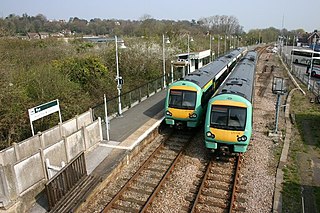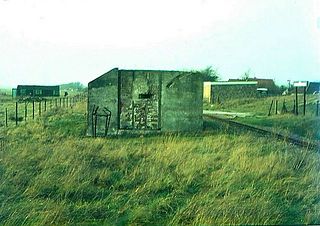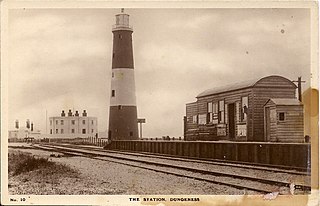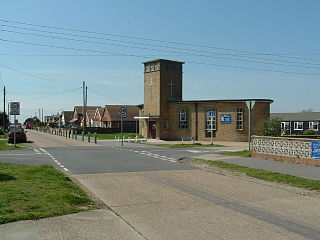
New Romney is a small town in Kent, England, on the edge of Romney Marsh, an area of flat, rich agricultural land reclaimed from the sea after the harbour began to silt up. New Romney, one of the original Cinque Ports, was once a sea port, with the harbour adjacent to the church, but is now more than a mile from the sea. A mooring ring can still be seen in front of the church. It is the headquarters of the Romney, Hythe and Dymchurch Railway.

Folkestone & Hythe is a local government district in Kent, England, in the south-east of the county. Its council is based in the town of Folkestone. The authority was renamed from Shepway in April 2018, and therefore has the same name as the Folkestone and Hythe parliamentary constituency, although a somewhat narrower area is covered by the district.

Dungeness is a headland on the coast of Kent, England, formed largely of a shingle beach in the form of a cuspate foreland. It shelters a large area of low-lying land, Romney Marsh. Dungeness spans Dungeness Nuclear Power Station, the hamlet of Dungeness, and an ecological site at the same location. It lies within the civil parish of Lydd.

The Marshlink line is a railway line in South East England. It runs from Ashford, Kent via Romney Marsh, Rye and the Ore Tunnel to Hastings, connecting to the East Coastway line towards Brighton.

Greatstone Dunes railway station was a station on the Romney, Hythe and Dymchurch Railway in Kent, England.

Dungeness was a railway station which served the Dungeness headland in Kent, England. Opened in 1883 by The Lydd Railway Company, it closed to passengers in 1937. Part of the line which served the station is converted to the main access road as a means of transporting atomic waste from nearby Dungeness nuclear power station.

Lydd-on-Sea is a modern village, mostly built after World War II, which consists mainly of bungalows built along the Dungeness coastal road south of Greatstone, Kent, England. The Southern Railway opened a railway station here in 1937 but was closed in 1967. Lydd-on-Sea is part of the ecclesiastical parish of Lydd, now several miles distant, which once had access to the sea.
Stagecoach in East Kent, which forms part of Stagecoach South East, operate many routes within the East Kent region. The company operate both frequent town routes to infrequent rural service; for example the Thanet Loop runs about every 7 minutes on Mondays to Fridays compared to the 123, which has just 4 journeys on Weekdays. The company have introduced a large number of new buses in the past few years to meet with the step free access law on buses which came into place in January 2017.

Lydd Town was a railway station which served the town of Lydd in Kent, England. Opened on 7 December 1881 by The Lydd Railway Company. It closed to passengers in 1967 but the line through the station remained open for freight.

Lydd-on-Sea Halt was a railway station which served the modern village of Lydd-on-Sea in Kent, England. The station opened in 1937 and closed in 1967.

Greatstone-on-Sea Halt was a railway station which served the modern village of Greatstone-on-Sea in Kent, England. The station opened in 1937 and closed in 1967.

New Romney and Littlestone-on-Sea was a railway station which lay in between the villages of New Romney and Littlestone-on-Sea in Kent, England. The station opened in 1884 and closed in 1967.

All Saints' Church, also known as Lydd Church or The Cathedral on the Marsh, is a church in Lydd, Kent, South East England. It belongs to the Diocese of Canterbury. All Saints is the longest parish church in Kent at 199 feet (61 m), and also has one of the tallest towers in the county at 132 feet (40 m). The church is thought to incorporate a small Romano-British basilica possibly built in the 5th century, though most of the current fabric is medieval. It was associated with local fraternities or guilds in the 15th century and could seat 1,000 people at a time. Severely damaged by World War II bombing, the church was subsequently restored and is now a Grade I listed building.

The Rhee Wall is a former watercourse in Romney Marsh in Kent. It is 7.5 miles (12.1 km) long and runs from Appledore, on the north-western edge of Romney Marsh, south-east through Snargate, Brenzett and Old Romney, to New Romney near the coast. The Rhee Wall forms a boundary between Romney Marsh proper, to the north-east, and Walland Marsh to the south-west.
Folkestone & Hythe District Council is the local authority for the Folkestone & Hythe district in Kent, which was known as Shepway until 2018.























